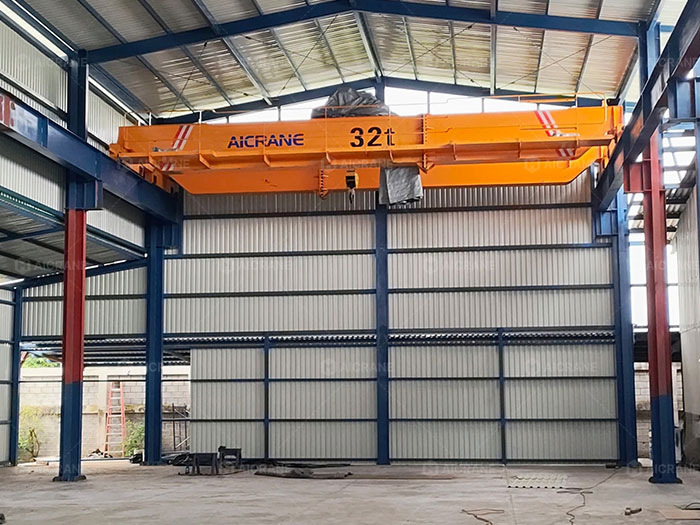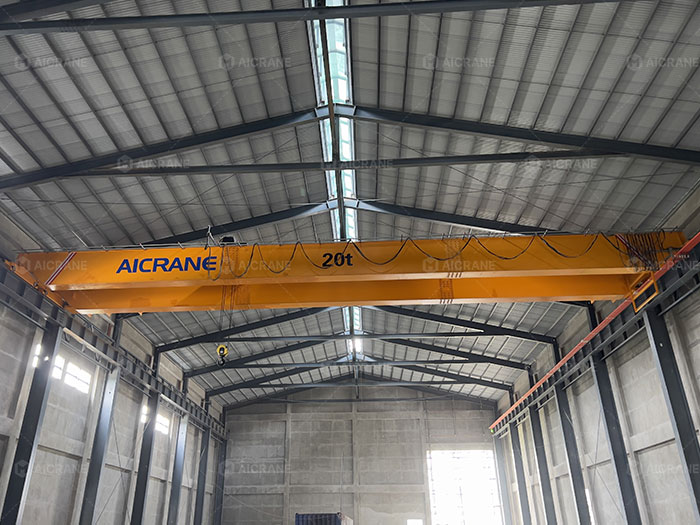Overhead Electric Overhead Traveling (EOT) cranes are integral to material handling in a wide range of industrial sectors, including manufacturing, logistics, steel production, power generation, shipbuilding, and more. A critical factor that shapes the structural design of an overhead EOT crane is its load capacity—the maximum weight it is engineered to lift safely. From girder configuration and material selection to component sizing and support structures, capacity plays a defining role in determining every aspect of a crane’s design.
This article explores how capacity influences the structural design of overhead EOT crane for sale and provides insight into why understanding this relationship is crucial for ensuring performance, safety, and long-term reliability.

1. The Relationship Between Capacity and Structural Requirements
The load capacity of an overhead crane can range from a few tons for light-duty applications to over 500 tons for heavy industrial processes. As capacity increases, so do the mechanical forces, structural stresses, and safety demands placed on the crane. The structural design must be optimized to handle these forces efficiently, without excessive weight or cost.
Key structural components affected by capacity include:
-
Bridge girders (single or double)
-
End trucks
-
Runway beams and columns
-
Trolley and hoist systems
-
Rail and wheel arrangements
-
Bracing and connections
2. Girder Configuration: Single vs. Double Girder Design
Single girder cranes are typically used for capacities under 20 tons and spans less than 25 meters. They are lighter, more economical, and easier to install. However, when capacity increases, double girder cranes become necessary due to their enhanced structural strength and ability to support heavier hoists mounted between or on top of the girders.
Implications of capacity on girder design:
-
Low-capacity cranes (e.g., 1-10 ton overhead cranes): Use a single box or rolled section girder with minimal bracing.
-
Mid-capacity cranes (10-50 ton overhead cranes): May require single or double girders with reinforced webs and flanges.
-
High-capacity cranes (above 50 ton overhead cranes): Require double box girders with stiffeners, diaphragms, and strong cross-bracing to distribute stress and prevent deflection.

3. Material Selection and Cross-Section Design
The materials used in constructing an overhead crane must offer a balance between strength, weight, and cost-effectiveness. As load capacity increases, the structural components are subject to more bending, shear, and torsional forces.
-
Mild steel is sufficient for up to 20 ton overhead cranes.
-
High-tensile steel or hybrid materials may be necessary for cranes above 50 tons.
-
Welded box sections are preferred for high-capacity cranes due to their superior strength-to-weight ratio and resistance to torsion.
Cross-sections of girders and beams are designed to limit deflection (usually L/750 or L/1000) and to maintain rigidity under dynamic loading.
4. Trolley and Hoist Considerations
The hoist mechanism must be directly aligned with the crane’s rated capacity. As capacity increases, the size, weight, and drive power of the hoist and trolley also increase, influencing the crane’s structural design.
Design implications include:
-
Heavier hoists require stronger support frames and beams.
-
Large-capacity hoists may need a custom trolley frame to ensure proper load distribution.
-
The impact factor due to hoist operation (especially during start/stop) increases with weight, which affects fatigue design.
5. Wheel Load and Runway Design
Crane capacity directly influences the wheel loads – the force transferred to the wheels and subsequently to the runway and building structure. For higher capacities, each wheel supports a greater share of the crane’s gross load.
Design impact includes:
-
Larger or more numerous wheels to distribute load more effectively.
-
Heavier rail sections or even crane rail pads to dampen vibration.
-
Reinforced runway beams and support columns to handle increased vertical and horizontal forces.
-
Expansion joints and buffers become more critical in managing load transitions.
6. Crane Span and Deflection Control
As crane capacity increases, deflection control becomes more complex, especially over longer spans. Excessive deflection can affect hoist operation, cause load sway, and reduce positioning accuracy.
Design measures to counter deflection:
-
Use of cambering (intentional upward bend) in girders to offset anticipated deflection.
-
Addition of stiffeners and diaphragms to increase girder stiffness.
-
Careful analysis using FEM (Finite Element Method) to simulate load paths and optimize section geometry.
7. Braking, Control Systems, and Drive Units
High-capacity cranes require powerful motors and braking systems to control acceleration, deceleration, and emergency stops. The dynamic forces introduced during motion put additional stress on the structure.
Considerations for high-capacity cranes:
-
Dual-motor drives for synchronized operation and load balancing.
-
Heavy-duty brakes with fail-safe operation.
-
Variable frequency drives (VFDs) to provide smooth acceleration and deceleration, reducing structural impact.
-
Reinforced gearboxes and couplings to handle increased torque.
8. Seismic and Wind Considerations
For outdoor or seismic-zone applications, capacity also impacts how the structure is designed to resist external loads:
-
Heavier cranes increase the seismic mass, which must be accounted for in the base shear calculation.
-
Wind loads on crane girders and hoists can introduce lateral forces that must be resisted by bracing and rail clamps.
-
Load swing becomes more pronounced with heavier payloads, requiring anti-sway systems or improved operator controls.
9. Safety and Redundancy in Design
Higher-capacity cranes demand a greater margin of safety, as failure can result in catastrophic damage or injury. Codes such as FEM, CMAA, ISO, or ASME set safety factors and classification standards that become stricter with increasing capacity.
Key safety features:
-
Redundant brakes or dual hoisting mechanisms.
-
Load limiters and real-time load monitoring.
-
Emergency stop systems and fail-safe logic in control panels.
-
Periodic inspection protocols for fatigue-prone components.
10. Building Integration and Support Structure
When installing a high-capacity EOT crane, the building’s structure – columns, roof trusses, bracing, and foundations – must be designed to handle the concentrated crane loads.
Structural influences include:
-
Runway beams must be braced laterally to prevent torsion.
-
Columns may require thickened sections or auxiliary supports.
-
Foundations must resist uplift and dynamic loading from crane movement.
If retrofitting into an existing building, structural reinforcement or redesign may be necessary to accommodate the added crane capacity.
Conclusion
The capacity of an overhead EOT crane is not just a technical rating – it is a defining factor that influences nearly every aspect of structural design. From the type of girder and material selection to runway beam design, trolley mechanics, and building integration, increasing capacity introduces complex design challenges that require precise engineering solutions.
Choosing the right crane capacity involves balancing current needs with future scalability. Over-designing can lead to unnecessary costs, while under-designing poses safety and operational risks. That’s why working with experienced overhead crane manufacturers and structural engineers is essential to tailor a crane system that performs reliably under all expected load conditions.
If you are planning to install a new EOT crane or upgrade an existing system, contact our engineering team today. We offer customized crane solutions designed to match your capacity requirements and operational goals with safety and efficiency.
